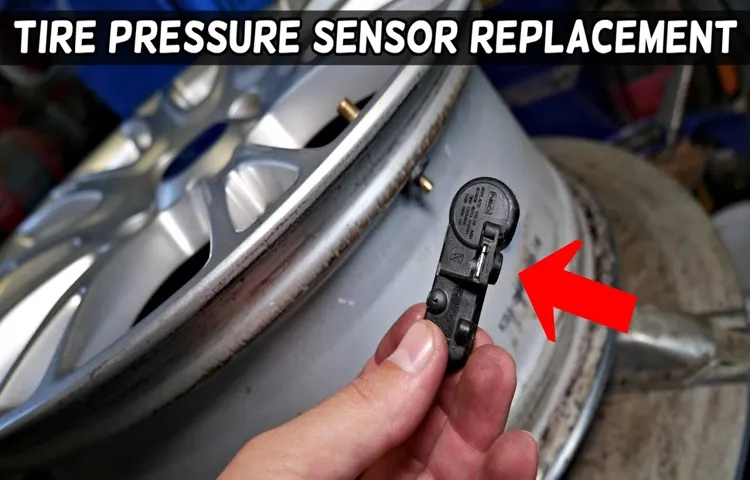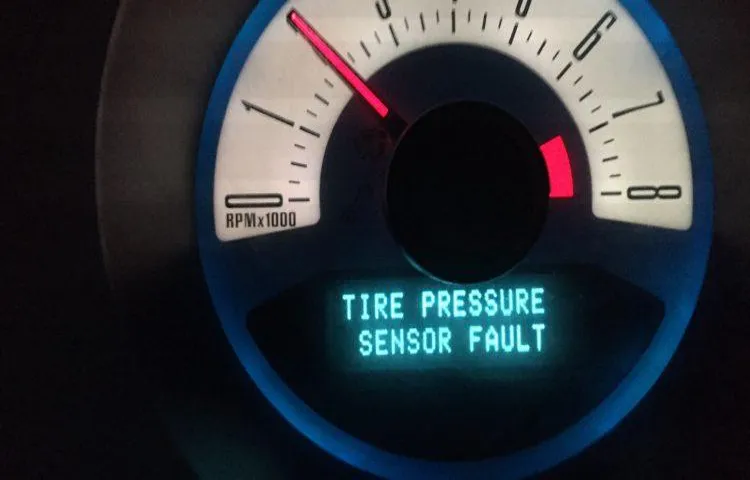If you’ve ever been driving along and suddenly heard a warning beep followed by the phrase “Tire Pressure Monitor Fault,” you’re not alone. This is a common issue that many drivers face, and it can be quite frustrating. But what exactly does it mean? And what should you do about it? Simply put, a tire pressure monitor fault means that there’s a problem with the system that monitors the air pressure in your tires.
This could be due to a variety of factors, including a malfunctioning sensor, a dead battery, or even just a piece of debris that’s blocking the sensor’s signal. Whatever the cause, it’s important to address the issue as soon as possible to ensure your safety on the road. One analogy you could use to better understand the issue is thinking of your tire pressure monitor as a canary in a coal mine.
Just like a canary would warn miners of dangerous gases, your tire pressure monitor warns you of potential hazards on the road. Ignoring the warning could lead to a blowout or other dangerous situations, putting you and your passengers at risk. So, if you encounter a tire pressure monitor fault, don’t ignore it.
Instead, take your vehicle to a trusted technician who can diagnose and fix the issue. In the meantime, you can manually check the pressure in your tires and ensure they’re properly inflated to prevent any further damage.
Table of Contents
What is a Tire Pressure Monitor (TPM)?
If you’ve recently had a tire pressure monitor fault, you might be wondering what exactly a TPM is. Simply put, a tire pressure monitor is a system in your car that tracks your tire pressure. These systems use sensors inside each tire to keep track of the tire pressure and alert you if one or more of your tires is underinflated.
This is important because driving on underinflated tires can be dangerous and can lead to poor handling and decreased fuel efficiency. If you do experience a TPM fault, you should have your system checked by a mechanic to ensure it’s working correctly. It’s always better to be safe than sorry when it comes to tire safety.
Explanation of TPM and its Components
Tire Pressure Monitor (TPM) A Tire Pressure Monitor (TPM) is a device used to monitor the air pressure in a vehicle’s tires. The system includes a sensor placed inside each tire that sends a signal to the vehicle’s computer system, informing it of the tire pressure. The device has two main components, the sensor and the receiver.
The sensor is positioned inside the tire, and it measures the tire pressure, including the temperature and pressure levels. On the other hand, the receiver processes the data received from the sensor and displays the readings in a user-friendly interface. The TPM helps drivers maintain optimal tire pressure, improving fuel efficiency, tire life, and overall safety on the road.
In case of any abnormalities in tire pressure, the system sends an alert to the driver, who can quickly address the issue before it causes any severe damage. So if you want to ensure the longevity and safety of your tires, installing a TPM system is a wise decision.

What Causes TPM Faults?
If you own a car with a TPM (tire pressure monitor) system, you may have experienced a tire pressure monitor fault. There are several causes that can trigger this issue. One of the most common is a low battery level in the TPM sensor.
In some cases, the sensors might not be able to communicate with the control module due to a weak battery, leading to false readings or no readings at all. Another reason is damage to the sensors due to driving over potholes or curbs. The sensors are delicate and can easily break, causing a faulty reading.
Furthermore, moisture or water can get into the sensors and corrode them, which can also lead to false readings. If you experience a TPM fault, it’s essential to get it checked out as soon as possible as it can affect your car’s safety.
Possible Causes of TPM Malfunction
TPM faults can be caused by a number of factors, including hardware malfunctions, software errors, and user mistakes. In terms of hardware, a fault in the sensor or wiring can cause the TPM to malfunction. Software errors can occur if there are bugs or glitches in the TPM firmware or driver software.
User mistakes, such as accidentally deleting or modifying TPM keys or certificates, can also cause TPM problems. Additionally, TPM faults may be caused by third-party software conflicts or security policy issues. It’s important to regularly check and update TPM firmware and driver software to prevent and address potential faults.
Proper user education and training is also vital to prevent accidental errors. Overall, staying proactive and aware of these possible causes can help ensure a smoothly functioning TPM system.
Effects of Overinflated or Underinflated Tires
TPM Faults One of the most common causes of TPM (Tire Pressure Monitoring) faults is overinflated or underinflated tires. When the air pressure in a tire is either too high or too low, it can trigger the TPMS (Tire Pressure Monitoring System) to send an alert to the driver. The result could be a distracting warning light on the dashboard or an audible beep.
But why does this happen? Overinflated tires can cause the center of the tire to wear faster, reducing tread life and affecting vehicle handling. Underinflated tires can cause excessive sidewall flexing, which can lead to a blowout. The best way to avoid TPM faults caused by overinflated or underinflated tires is to maintain the recommended air pressure levels for your vehicle.
Regularly checking your tire pressure can help prevent unnecessary wear and tear on your tires and keep you safer on the road.
How to Detect TPM Faults?
Tire pressure monitor faults can be annoying and hazardous, especially when you’re not sure what’s causing them. But worry not, as detecting TPM faults requires minimal effort. First and foremost, if your tire pressure light turns on, check your tires’ pressure.
If you find that they’re too low, fill them up according to the manufacturer’s instructions. If the light stays on, it’s likely due to a faulty sensor. Inspect your tires to see if any are low on air or visibly flat.
If all seems fine, take your car to a reputable mechanic or tire shop, and have them perform a diagnostic check on your TPM system. Also, keep in mind that extreme temperatures can cause the TPM sensors to malfunction, so if you live in an area prone to temperature changes, always be vigilant of your tire pressure readings. Overall, being proactive with your tire maintenance can prevent TPM faults and keep you safe on the road.
Symptoms of a TPM Faulty Sensor
If you own a vehicle with a TPM (Tire Pressure Monitoring) system, it is crucial to know how to detect TPM faults. One of the most common symptoms of a faulty TPM sensor is a warning light illuminated on the dashboard. This dashboard light can indicate low tire pressure or a more severe issue with the TPM system.
Other symptoms may include fluctuating tire pressure readings or inaccurate pressure readings. A TPM system using radio frequency sensors can also experience interference from other electronic devices or environmental factors like a nearby airport or power lines. So, it is essential to take note of any of these symptoms and bring your vehicle to a professional mechanic to diagnose the issue and replace any faulty TPM sensors.
Ignoring these symptoms can lead to safety risks, lower fuel efficiency, and increased tire wear, so it’s crucial to detect TPM faults as soon as possible.
Using TPMS Diagnostic Tool to Detect Faulty Sensors
TPMS Diagnostic Tool If you’re experiencing issues with your car tire pressure, there might be an issue with your TPMS sensors. The TPMS diagnostic tool is a great tool to help you easily detect any faults and diagnose the issue with your sensors. It allows you to read the sensor ID, tire pressure, and temperature.
These readings are important in detecting the faulty sensor by comparing the readings of the other sensors. If the readings of one sensor are different from the other sensors, it is possible that the sensor is malfunctioning. With TPMS diagnostic tools, you can easily detect the faulty sensor and diagnose the problem.
This can save you time and money in the long run by detecting and correcting the issue sooner rather than later. So if you’re experiencing issues with your car tire pressure, consider investing in a TPMS diagnostic tool to help you easily detect and correct any faults.
Fixing TPM Faults
Tire pressure monitor faults can be frustrating for drivers, as they can cause the TPMS light to come on and stay on. But what exactly causes these faults? It can be anything from a dead TPMS sensor battery to a faulty module. The good news is that most TPMS faults can be fixed by a professional, making it important to take your vehicle in for a checkup as soon as you notice the TPMS light on.
Additionally, it’s crucial to ensure that your tires are properly inflated to avoid any unnecessary wear and tear on your vehicle. In short, while tire pressure monitor faults can be a hassle, they’re easily fixable and can help prevent more significant issues down the road.
Steps to Fix Faulty TPM Sensors
TPM sensors are an integral part of vehicles nowadays as they help maintain optimal tire pressure and improve fuel efficiency. However, faulty TPM sensors can cause significant issues, such as incorrect tire pressure readings, illuminated warning lights, and reduced traction. Fixing a faulty TPM sensor requires some straightforward steps to ensure the tire pressure monitoring system works correctly.
First, check if the tires are properly inflated and that there are no punctures or cracks on the tire walls. Afterwards, inspect the battery of the sensor to ensure it has enough charge to function correctly. If the issue persists, replacing the sensor may be necessary, and it is recommended to visit a licensed mechanic to do so.
Remember, accurate tire pressure readings are essential for safety on the road, so it’s vital to identify and fix TPM faults as soon as possible.
Services that Offer TPM Repair and Replacement
If you’re experiencing issues with your Trusted Platform Module (TPM), it’s crucial to get it repaired or replaced by a reputable service provider. A faulty TPM can lead to significant security risks, potentially exposing sensitive data and leaving your device vulnerable to attacks. Fortunately, there are several services that offer TPM repair and replacement, ensuring that your device is secure and functioning properly.
These services can diagnose the issue with your TPM, replace faulty components, and reconfigure your device’s firmware to restore its functionality. Don’t wait until it’s too late – if you suspect that your TPM is faulty, seek out a reliable repair or replacement service to protect yourself and your valuable data.
Conclusion
In summary, a tire pressure monitor fault is like having a nagging backseat driver constantly reminding you to check your tire pressure. In this case, however, it’s the vehicle’s onboard computer system doing the nagging. While it may be annoying at times, it’s an important safety feature that shouldn’t be ignored.
So, don’t let a tire pressure monitor fault deflate your safety standards and be sure to get it checked out by a professional as soon as possible!”
FAQs
What is a tire pressure monitor fault?
A tire pressure monitor fault is a warning light that appears on the dashboard of a vehicle indicating that there is an issue with the tire pressure monitoring system.
What are the common causes of a tire pressure monitor fault?
The common causes of a tire pressure monitor fault are faulty sensors, low battery level of sensors, damage to the sensor housing, and contaminated sensors.
How does a tire pressure monitor fault impact the vehicle’s performance?
A tire pressure monitor fault can lead to decreased fuel efficiency, uneven tire wear, poor handling, and higher chances of a blowout or a flat tire.
How can I troubleshoot a tire pressure monitor fault?
You can troubleshoot a tire pressure monitor fault by checking the tire pressure of all the tires of your vehicle using a tire pressure gauge, replacing the faulty sensor, resetting the tire pressure monitoring system, and checking the battery level of the sensors.
Is it safe to drive with a tire pressure monitor fault?
It is not recommended to drive with a tire pressure monitor fault as it increases the risk of accidents and jeopardizes your safety on the road.
Can a tire pressure monitor fault be fixed without professional help?
A tire pressure monitor fault can be fixed without professional help in some cases, but it is recommended to seek professional help to avoid any damage to the sensors and to ensure proper functioning of the tire pressure monitoring system.
What is the cost of repairing a tire pressure monitor fault?
The cost of repairing a tire pressure monitor fault varies depending on the severity of the issue and the type of vehicle. It can range from anywhere between $50 to $250 or more.



